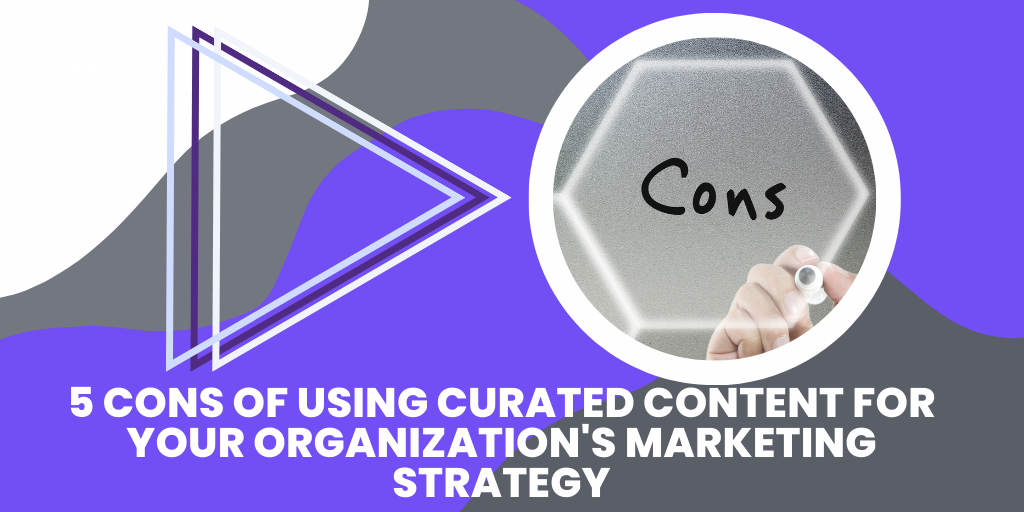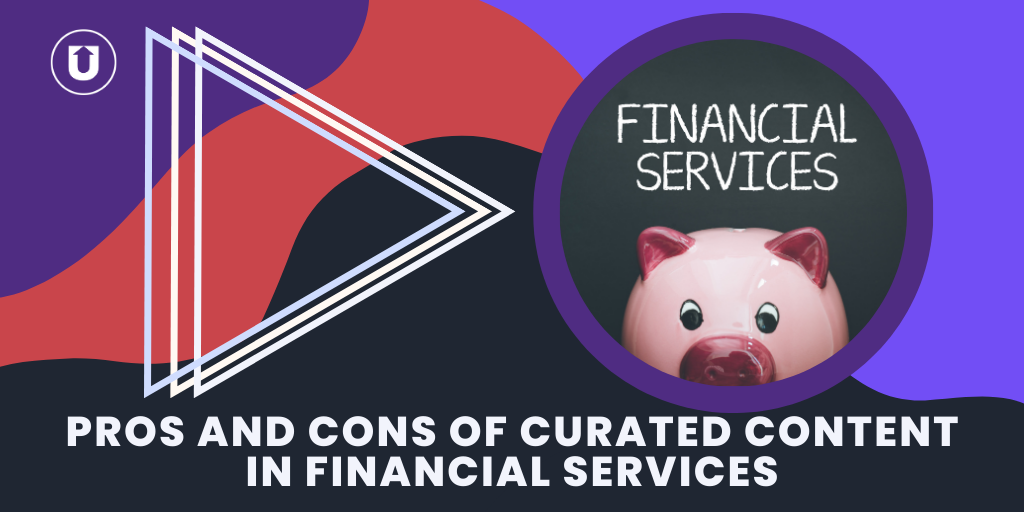5 Cons Of Using Curated Content For Your Organization's Marketing Strategy

Before we dig into the cons, it is important to note that these are for your company's brand and do not directly translate to the use of curated content for a personal brand.
When you Google “cons of curated content,” many articles in the top search results were published in 2012, 2015, or even 2018.
Most of these articles recommend not using curated content at all, citing that original content is the only way to build authenticity with your audience.
But if you’re in the world of content marketing, you know that strategies and methods have changed, and continue to change quickly!
Just a couple of years ago, HubSpot retired its marketing funnel, and they created it!
If HubSpot is willing to change its perspective and how they approach inbound marketing, we should be willing to examine our perspective on curated content.
Here at UpContent, we have been helping organizations develop and grow their content curation strategies since 2017, and we have observed several pros and cons of using relevant third-party content.
In this article, we will go over five of the biggest cons in content curation today (not 10+ years ago) and some solutions to avoid falling into the problem pitfalls these cons can create.
Con #1: Limited Control over the Content
As a company or brand, you must be careful what you share with your audience.
You want to ensure whatever you’re distributing aligns with the brand and company values and doesn’t confuse or distract your audience from the overarching message you’re trying to convey.
When curating content for your company, you naturally will have more limited control of what that content consists of.
You also have no control over the content's tone and messaging, which can create issues if the content you share doesn’t align with your brand’s values, voice, or messaging.
Solution for Limited Control
Back in the early 2010s, content curation software acted more like content aggregation tools, which can be helpul in bringing together all the articles you’d like to consider into one screen or platform.
But they didn’t provide the necessary filtering required to surface only the content that was worth considering and, if automatic sharing was enabled, would often result in flooding your channels with articles and diluted your core message.
We experienced this first-hand and it is this experience that prompted us to build UpContent to offer a better and more automated way of pulling the best of the best in third-party content for companies to easily review (think less than 20 minutes of time per week) before sharing with their audiences.
While content curation doesn’t have to take a lot of time, the way content is surfaced, filtered, and organized must be intentional in order to see the benefit from including third-party articles in your strategy.
Like most inbound marketing efforts, the content your brand elects to share must be both individually and collectively valuable to those you wish to have a relationship with.
Ensure you research sources and read the content before sharing it on company profiles, email lists, and your website.
This doesn’t have to be a full-time job and could easily be divided amongst your team, who are already experts in the topics you’re sharing content around.
Con#2: Curated Content Doesn’t Convert As Easily
When you send your followers to another website to read their content, how in the world are you supposed to convert them?
While curated content can help establish credibility and authority in your industry, when considering each piece individually, it doesn’t provide as clear of a conversion action as your reader would find within your original content or web page.
The pieces you curate will often have their own objectives (which are not to bring you more customers) and while it can feel a bit uneasy to send traffic to another domain, it is an important step in showing confidence in your own value proposition and your brand’s belief that an informed customer is the best customer.
Solutions To Convert Your Audience With Curated Content
While curated content often doesn’t have the ability to drive direct conversions, that doesn’t mean that converting readers shouldn’t be an objective of your curation strategy.
There are plenty of ways to ensure you’re establishing yourself as the solution for your customers using curated content, such as consistently sharing a mix of original and curated content to be the trusted resource, using a banner CTA that pops up over shared articles, or even enabling remarketing pixels.
But something else to keep in mind is that if you’re tracking to track conversion to every piece of content your company is sharing, original or curated, you’re going to get frustrated with those numbers.
That’s not how building your brand’s expertise works; it all works together. Sales isn’t a linear process for your team or your prospects, so you’re tracking has to adapt.
Con #3: Lack Of Originality
Can’t anyone share the same curated articles as your organization?
Doesn’t including third-party articles make it harder for someone to find your original thought leadership?
Sharing other people’s content does, by its very nature, mean that others have access to, and can share, the same article with their audience as well.
If you over index on curated content without being intentional about making room for original thought leadership, it can be difficult for the engagement you’ve created to be focused back upon your brand.
Solutions for Lack of Originality
The easiest way to prevent this con from tanking your content curation strategy is by adding your company’s opinions, thoughts, or views as a caption or comment when sharing third-party content.
If you’re sharing any content for your brand with no context or explanation, it may still be valuable for your audience (assuming that you’ve still filtered to only share what’s relevant).
But that content won’t do much to inform your audience about your brand and help them make the connection between the value they gained from the article and your expertise.
As a brand, you need to cut through that noise with expert information.
Curated content can uniquely achieve this by showcasing this expertise through the knowledge of others - as long as there is a well-considered and intentional strategy behind what you are sharing.
This doesn’t have to take much time, but it requires some thought and strategy.
Con #4: Impact on SEO
Search engine optimization (SEO) is vital to any digital marketing strategy, whether it’s your organic web traffic or the rapidly maturing field of social media search.
While using curated content does not have a direct impact on your SEO, you are still sending people away from your site.
You’ll receive the credit for the click away, but once they leave, it can be hard to get those customers back without a plan in place.
Solutions for SEO Impacts
Here at UpContent, we recommend never copying and pasting someone else’s work and publishing it on your site.
This can cause legal issues, but as stated earlier, it negatively hurts your SEO.
Instead, we found that linking to the original content is a “win-win” for your company and the original publisher.
You receive the engagement from the click (as long as you aren’t presenting the curated snippet in an iframe), and they receive the traffic from someone visiting their article.
When using UpContent, you have the option of using our Sniply integration, creating a banner CTA that gives people the option to click back to a landing page of your choice, and you can activate remarketing pixels so they will continue to see your ads for 90 days!
Con #5: Risk of Copyright Infringement
This can damage your business’s reputation and potentially lead to legal issues.
It’s the same as when we were in school; you can’t take someone else’s work. That’s cheating.
The same applies when using third-party content.
Content curation isn’t taking someone else’s work and using it as a way to avoid creating your own content.
You should be using it to expand your company’s expertise by using their sources with proper attribution.
Solutions to avoid copyright infringement
To avoid copyright issues, giving proper credit to the original author and seeking permission before using their content is essential.
We always recommend sharing a link to the original publisher, whether you’re sharing on your website, social media profiles, emails, or internal threads.
Copying and pasting is only recommended for sharing the link to the original article.
It is important to note that simply providing a “credit” at the bottom of a blog post that duplicates another publisher’s content is rarely considered proper attribution.
If your planned use of third-party articles includes republishing a portion of the original author’s work, we highly recommend consulting with a legal professional on proper use and potential consequences for violating the publisher’s copyright.
Next Steps To Avoid Cons With Curated Content
So how do you avoid falling into these current pitfalls with curated content? Be intentional about your use of third-party articles and their purpose alongside your original content.
Do we sound like a broken record yet?
Almost every issue with curated content comes from thinking curated content should replace original content in a marketing strategy, or that curation is simply the sharing of content you don’t have to write in order to “fill the void.”
This couldn’t be further from the truth
Instead, content curation should be used to amplify the content your company is creating and demonstrate that you’re aware of what’s happening in the industry, and it’s something your followers should know too.
If you want to re-examine or build your content curation strategy, talk with one of our Content Curation Experts today!
Or, if you’d like to read more about content curation, check out some of these articles.
Five Benefits of Using Curated Content on Twitter for Thought Leadership
What’s the Difference Between Content Curation and Aggregation?



